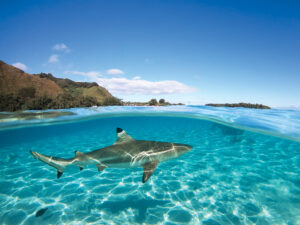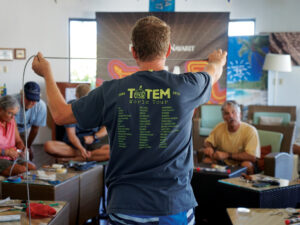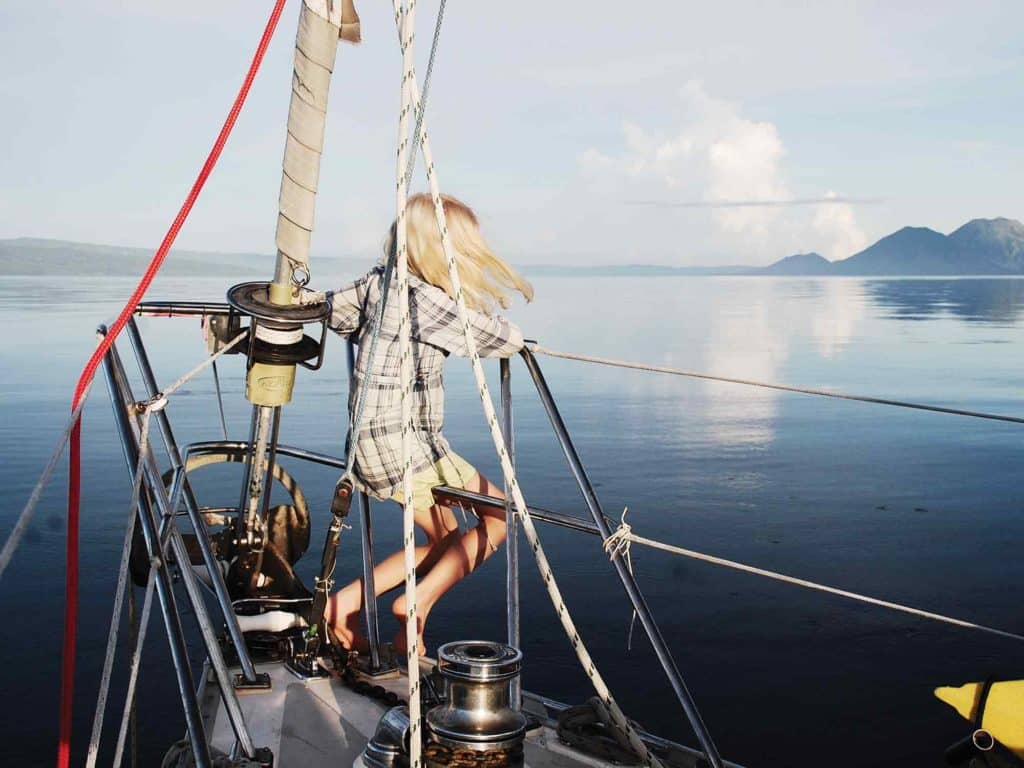
“I can hear them!” our son, niall, calls triumphantly from the side of Totem. We’re swinging gently at anchor in Banderas Bay, Mexico. At about 20 miles wide by 14 miles long, the large bay is a migratory destination for humpback whales, and the pods are arriving in force. Whale song resonates through the hull at our location on the fringe of the cruising fleet clustered off La Cruz. The sound is much clearer underwater, so our teenage daughters, Mairen and Siobhan, follow him in, and soon all three are marveling at the cetacean sounds. For our 20-year-old boat-kid graduate’s homecoming during a holiday break from college, hanging out under the keel to listen to the whales is a poetic return to his roots afloat.
Ten years ago, we departed from this very anchorage for our first big passage as a family. After a year and a half of mostly coastal cruising, Totem’s bow pointed over the blue horizon to the South Pacific. This big step was the culmination of many smaller ones in nearly a dozen years of cruising so far. The first step was back in September 1991. That’s the year I nervously stepped aboard a J/35 for a weekend of racing and bumped into a cute skipper who would one day become my husband. Jamie’s idea of courting was offshore racing and sharing his copy of Dove, Robin Lee Graham’s memoir of the nearly five years he spent circumnavigating as a teenager. It worked. Jamie showed me that travel and sailing nested together. His dream became our dream, for someday.
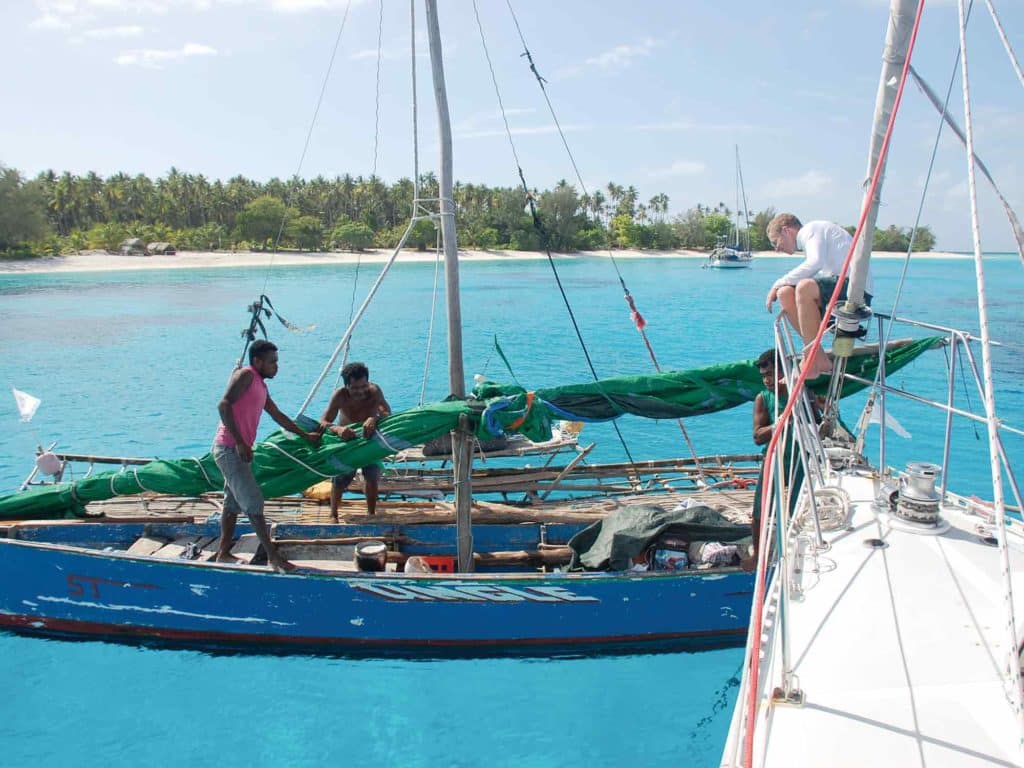
Like many dreamers, our “someday” had no timeline. Departure was beyond an unknowable future of careers and kids and picket fences. Genre literature largely modeled cruising as a pursuit for two (often retired) adults, not a young family of five.
Fuzzy planning gained focus during a tumultuous spring when in the span of a few weeks, our family experienced a birth, two cancer diagnoses and a death. Holding our 2-week-old daughter, Mairen, at Jamie’s mother’s funeral, we keenly felt the tragedy of her unrealized retirement dreams. For the first time, our perfect life felt like a perfect trap. What were we waiting for? We flew home to Seattle and called a real estate agent, the first major move to kick off a five-year plan to go cruising as a family.
Early Days: Conventional Cruisers
Six years and a surprise third child later, friends helped untie dock lines of our Stevens 47, Totem, from our home port of Bainbridge Island, Washington; Jamie and I pointed her bow out of the Strait of Juan de Fuca and southward.
Our kids, Niall, Mairen and Siobhan, were 9, 6 and 4 years old, respectively, when we set off. With three young children aboard, our motivations for cruising shifted away from the adventurous dreams of our 20-something selves. We hoped for at least a couple of years out, and had a financial plan for up to five; at that point, Niall would be ready for high school. During those years, our goal was to experience the magnificent diversity of our world as a family, in the many forms it can take: cultures, languages, climates, religions, flora, fauna. We hoped to raise citizens of the world with appreciation for their opportunities.
RELATED: Totem’s Interim Normal
Shifting into cruising mode took our children approximately a day. Years of Puget Sound daysailing and dinner-table dreaming about “The Big Trip” paid off. They had two parents to pay attention to them, and that’s all they needed. For Jamie, the transition took a few months. I struggled. Positive feedback loops from my professional life vanished overnight, my tiny new bosses issued irrational demands and suffered from capricious emotions, and my routine responsibilities lacked clear measurement beyond “we survived the day, and everyone was fed.” We were living the dream, yet I had never felt more adrift.
October 2008: San Diego, California. Surf pounded the beach where I sat with my friend Annie, a cruising parent and veteran who had brought her 6-year-old son, Bear, home to the boat after he was born. While our children ran shrieking in a game of tag with the fingers of the Pacific Ocean, I poured my heart out to the beat of crashing waves: the guilt over the unexpected difficulties in this new life, angst over homeschooling, fear of failure in the accumulation of these factors. Annie’s guidance was easier to hear, harder to internalize, but played out: “Trust in yourself, trust in your direction, and trust in the effort you have put into preparing.” Life changes aren’t easy. The most difficult part is believing up front that you will succeed when the simplest days can feel like a challenge. The voice in my head assures me this anxiety is common. Choosing lives that run counter to what our culture rewards takes confidence and strength.
The kids thrived, alleviating our fears about taking them from the only home they’d known, from a nurturing village of neighbors and friends and grandparents nearby, and an oversize house of toys to meet all wants. In fact, having less seemed to foster ingenuity in their imaginary play with each other; they didn’t need to be entertained, directly or through screen proxies, but developed concentration and the ability to work out what to do on their own.
A truism of the cruising life is it contains higher highs and lower lows. Highs from the extraordinary experiences the life enables, lows from the pressures imposed by life without a seatbelt. The real impact of everyday decisions makes life just that tiny bit more intense and spectacular and rarely terrifying. The trick is finding a balance: enough comfort in the requirements of seamanship and life in unfamiliar places to keep the lows at bay, and keeping an open outlook to the highs.
The kids thrived, alleviating our fears about taking them from the only home they’d known.
Like most new cruisers, we had a plan. We would voyage from our homeport to Mexico, then south to Panama and west to French Polynesia—all in the first year. And like most new cruisers, the plan did not line up with reality. We made a conscious decision to slow down, spend more time in Mexico, and find our rhythm. And it paid off. The highs of that first season included sailing with a mega-pod of dolphins, whales breeching next to our anchorage, and finding our tribe among the migratory cruising fleet. The lows were there but grew further apart as we became more familiar with our vessel’s creaks and groans, and gained comfort with how the boat and crew managed conditions. All of this helped me finally find my balance. We departed on the 2,900-nautical-mile passage from Mexico to the Marquesas a year later than originally intended but with a more confident crew aboard.
Route Planning by Necessity
Secured to a mooring in Tahiti, our little family sat around a big chart contemplating Totem’s future route. We’d been cruising for nearly two years, and only six months of funds remained in the cruising kitty.
“The Plan” had always been to sell our house on Bainbridge Island before we set sail. Yet when the time came, the real estate market crashed; our mortgage was underwater, so selling was no longer a viable option. Waiting for a market rebound wasn’t an option either. Instead, we set off with less than half the savings we had intended and a mortgage that exceeded rental income. As our funds trickled down, decisions loomed.
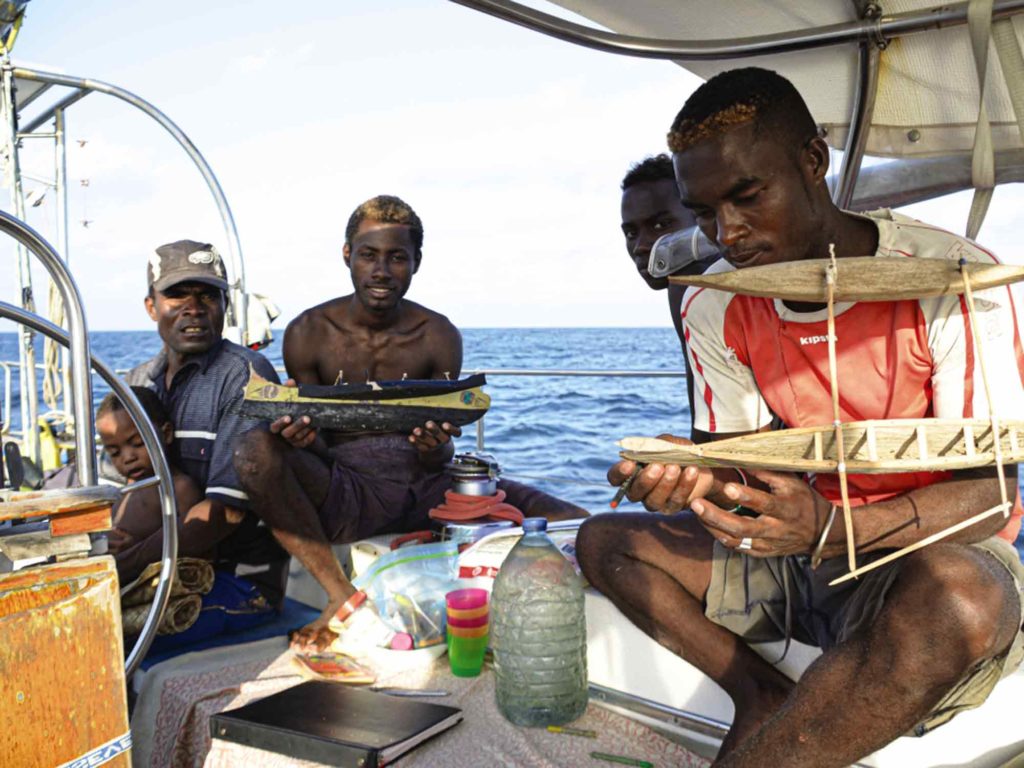
From Tahiti we considered paths out across the wide expanse of the Pacific, lines drawn out on the chart to possible destinations. The obvious option was to sail back to Puget Sound, resume jobs and school and normal lives, and declare victory on a sabbatical family cruise. However, none of us were ready to go home—back to the chart! Next came weighing route distances and job opportunities in places as disparate as Samoa, Guam, Singapore and New Zealand. After interviewing via Skype, a strong opportunity for me surfaced in Sydney. Now Australia became our end-of-season goal, about 4,000 miles and four months away. By most cruising standards, it was a dizzying pace through the Cook Islands, Tonga, Fiji, Vanuatu and New Caledonia; but in truth, the weeks in each of these exotic and stunning islands is a luxury by most standards, and it confirmed the joy of living adventurously.
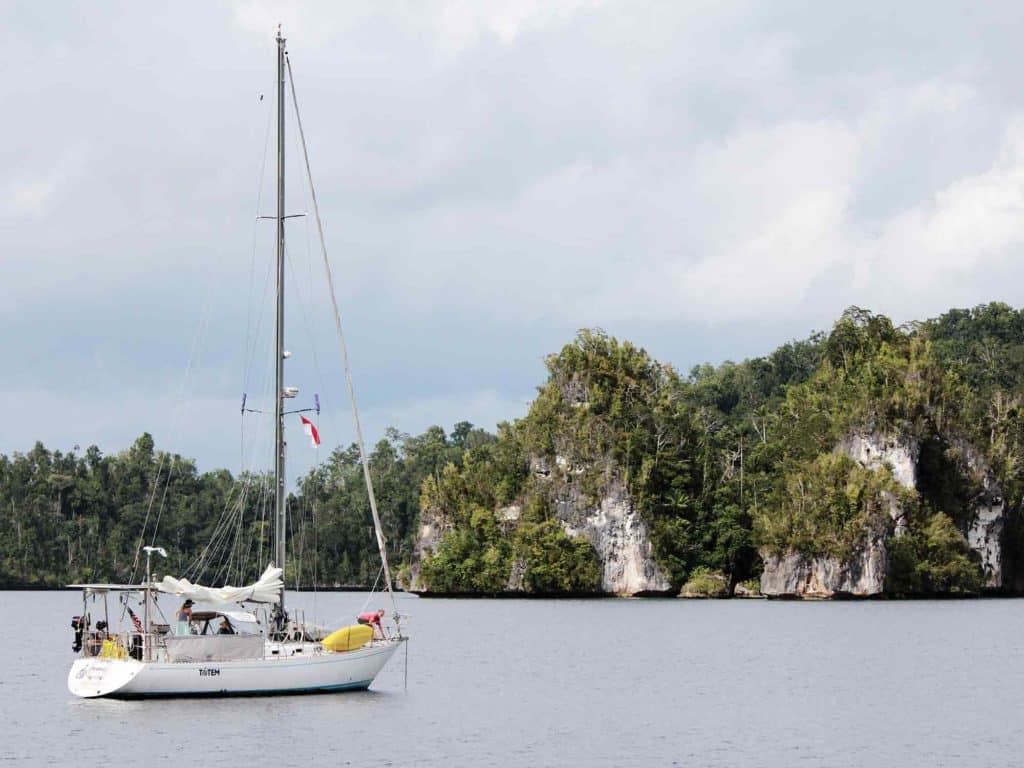
Looking back, we’re still cruising today because we couldn’t sell our house in 2008. Had the market held, a merry sabbatical would have arrived at a natural financial end concurrently with teen years and questions about what they were presumably missing out on. But because we couldn’t sell, we subsequently lived aboard while I worked in Australia for a year and a half. There, our family made two key discoveries: First, thanks to attending public schools in Brisbane before they really wanted to go back, our children concluded that homeschooled boat kids had a pretty good deal. Second, returning to professional/agency life—even with exciting clients and projects—showed me I no longer fit in; what I had once professed (and still believe) was the best job I’d ever have before we cut dock lines in the US lost its former glow.
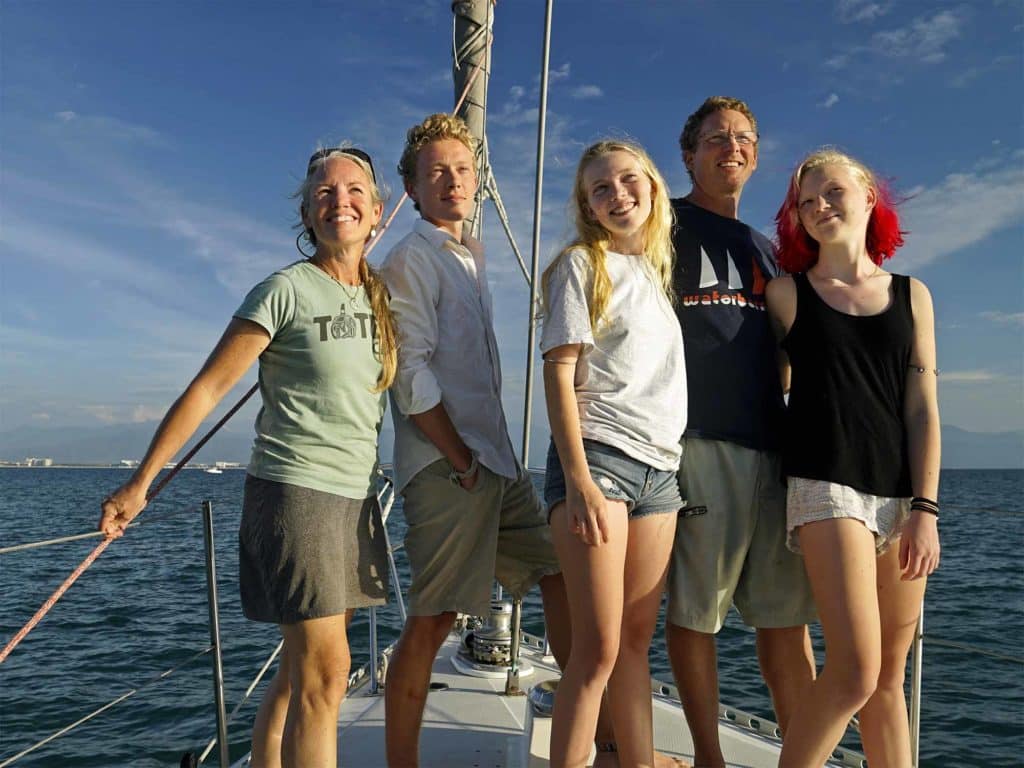
Finding a Way Forward
With savings banked to fund another couple of years afloat, it was time for another family meeting to choose the route away from Australia. Not interested in a Pacific loop back to Washington and high school, the kids helped map an adventurous plan. We’d start with an uncommon route through Papua New Guinea.
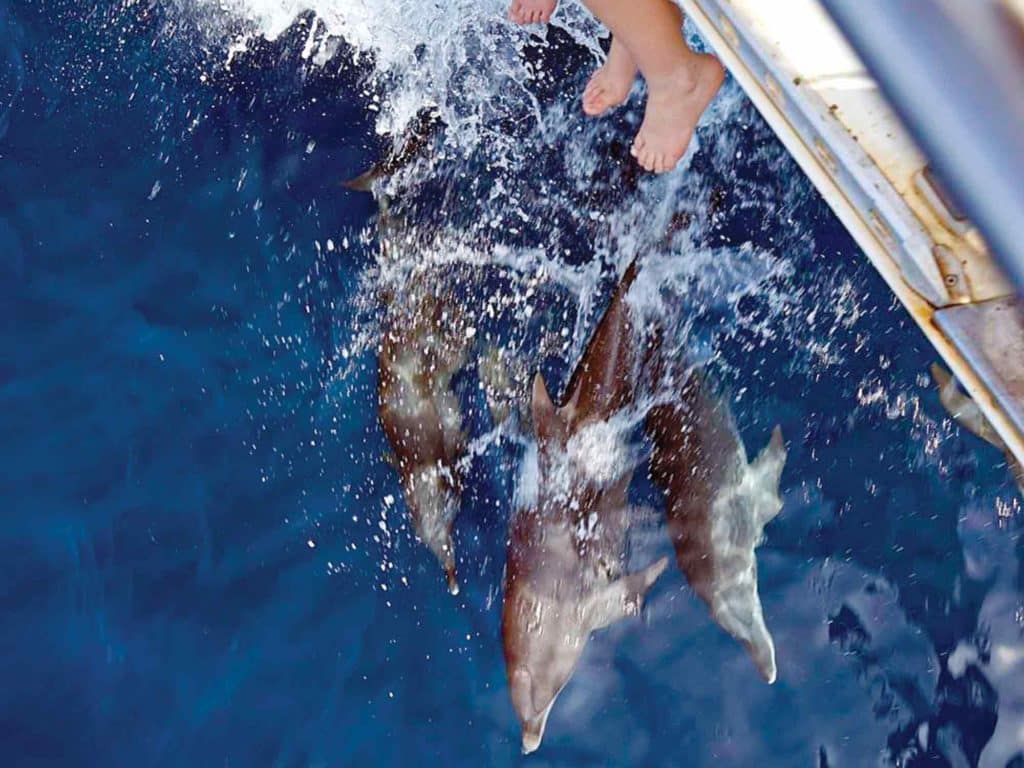
October 2012: Bramble Haven, Papua New Guinea. It’s been a rough passage to this placid atoll. Beam seas lifted and smacked Totem’s hull as we struggled through an unexpected squash zone after departing Australia. Three days of wet sailing with wind in the 40s was an appropriate cleanse for the transition from the bright lights in Queensland to the elemental life in Papua New Guinea. There, sandy footpaths replaced multilane highways. People wore tired rags or homemade clothes instead of disposable fashion. Local diets were comprised of about a dozen foraged or harvested choices, instead of innumerable options of heritage-variety handpicked-organic whatever that might have been flown in from afar.
As we picked between coral heads to find a sandy patch at anchorage depth, the outriggers with hand-sewn tarp sails that we noticed on the beach were a visual cue that we’d arrived in a dramatically different place. Their crews set up rustic camps in the uninhabited atoll for shelter during fishing forays away from their home islands. We met Sake on the beach, where he beachcombed for washed-up bits of fishing line to twist into rope for his canoe. Characteristic of those who have the least to give, Sake and his three sons with him were unfailingly generous with offerings from what they had: bananas, drinking coconuts, fish. When weather moderated enough for them to sail home, the men first sculled their outrigger to Totem to say goodbye. “If you come to Brooker, we’ll kill a chicken for you to have a feast!” A waypoint set, the tone of our new/old rhythm reestablished, and grateful to be omnivores, we wandered our way to reunite with the crew of the outrigger.
From there we sailed west to Indonesia, which I called home more than two decades ago in my early 20s, and aimed for mainland Southeast Asia, officially growing the miles between us and the USA instead of closing them. This was a new chapter: a bet on our ability to find new ways to support ourselves, and a new family dynamic as our children had grown into active crew and adventure-seekers.
We started testing work-from-anywhere ideas before leaving Australia. Jamie was a sailmaker in the ’80s and ’90s, and thanks to the internet, he was now a sailmaker again—working remotely to consult with customers on specifications for new sails, and coordinating the production and shipment of sails. I expanded my writing work, publishing in magazines and online, and later working on a book project with two other cruising parents: Voyaging with Kids, now the de facto guide to family cruising. These trickle income streams stemmed the flow from savings.
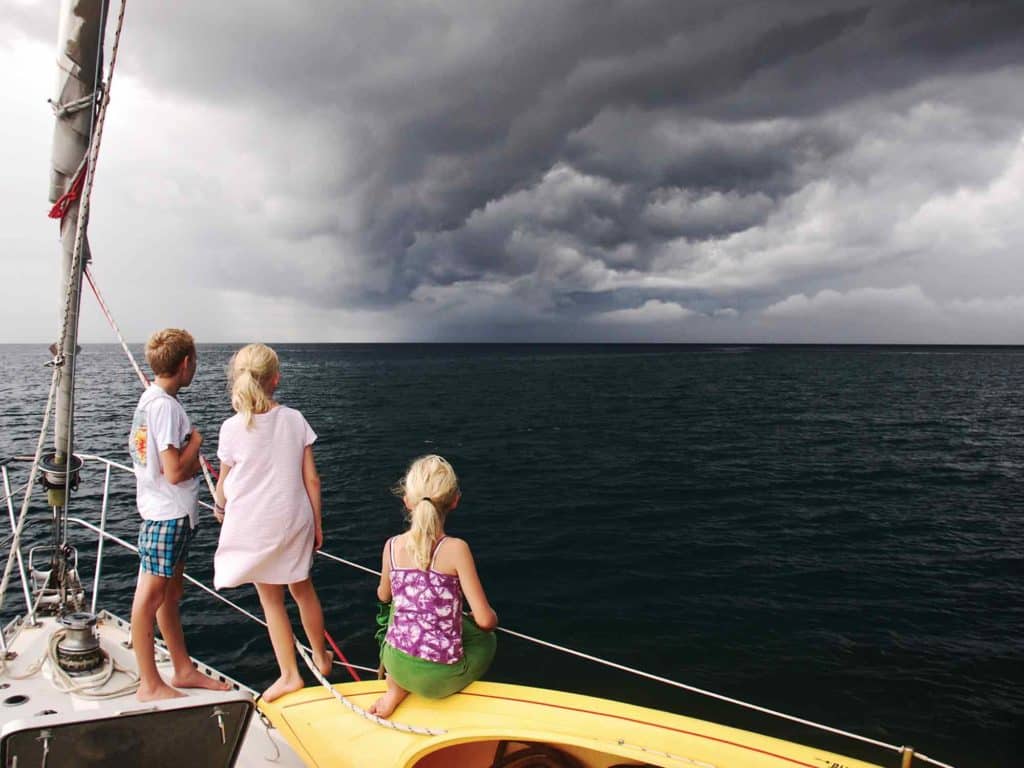
Cruising through Southeast Asia involves frequent motoring in little or no wind, but the combination of low-cost living, accessible internet and fascinating destinations definitely made up for the lack of good sailing breezes. Around the same time, rental prices for our property in Washington increased enough to change the house from a drain to net-zero cash flow. This helped open a new chapter of frugal freedom where we could travel based on seasonal weather patterns, provision as needed, and undertake maintenance and repairs as the budget allowed.
This was a new chapter: a bet on our ability to find new ways to support ourselves, and a new family dynamic as our children had grown into active crew.
Financially sustaining ourselves even partially brought new security and a bizarre comfort with poverty (by US standards). With one foot on the boat and one on the beach, we continued to string together the resources and ways to carry on while seasonally migrating from Borneo to Singapore, peninsular Malaysia, and Thailand for about two years.
Committed Cruisers
We sailed across the Indian Ocean in 2015 on a northerly route from Thailand to Seychelles before diving south to South Africa. Our family sought experiences so unfamiliar that they defied explanation: If you’ve walked on the moon, how do you explain how that felt to someone who has never been to the moon? The Indian Ocean was full of moon-walking experiences. Joining pilgrims in a pre-dawn climb up a holy mountaintop to view the sunrise in Sri Lanka. Foraging the Maldivian water’s edge for spicy salad greens and ghost crabs to grill in a beach fire. Freediving around neon coral fluorescing as a last gasp before bleaching in Chagos. Engaging in three days of extended dialogue to clear into Comoros, a process based on oral tradition instead of technology.
September 2015: Barren Islands, Madagascar. Siobhan offers our iPad, where she’s opened the game Fruit Ninja, to a Vezo tribesman seated in Totem’s cockpit. “You swipe with your finger to play, like this!” He doesn’t understand a word Siobhan is saying; it doesn’t matter, as our daughter takes his hand and drags it across the surface to demonstrate. Images of falling fruit split with his finger-slice. Another swipe, and our new friend gets the drift; soon he’s giggling away while rapidly chopping falling pineapples.
Our phrase book taught us how to ask “What tribe are you from?” and “Does your tribe have a king?”—amusing, but not helpful in our goal of ascertaining the community leader to explore trading. What we’ve dubbed Fruit Ninja Diplomacy has come to the rescue again, helping open communication and friendship with people we did not share a common language with. Sipping lemonade under our Bimini, women decorated with sandalwood paste waited their turn; one spoke enough French to begin stilted dialogue. Gifted scale models of the Vezo’s beautifully crafted canoes—Malagasy sand stuck to their roughly painted hulls—are now tucked in a locker to remind us of the value in making an effort to bridge language and cultural gaps.
The Indian Ocean sent us packing with 55-knot gusts from a system near Cape Agulhas. It had delivered tricky passages and challenging conditions, but also deeply rewarding destinations along a less typical path. As we looked north up the Atlantic from South Africa, family news signaled it was time to return home. Instead of crisscrossing to Gibraltar, less than six months after departing Cape Town, Totem arrived in the USA.
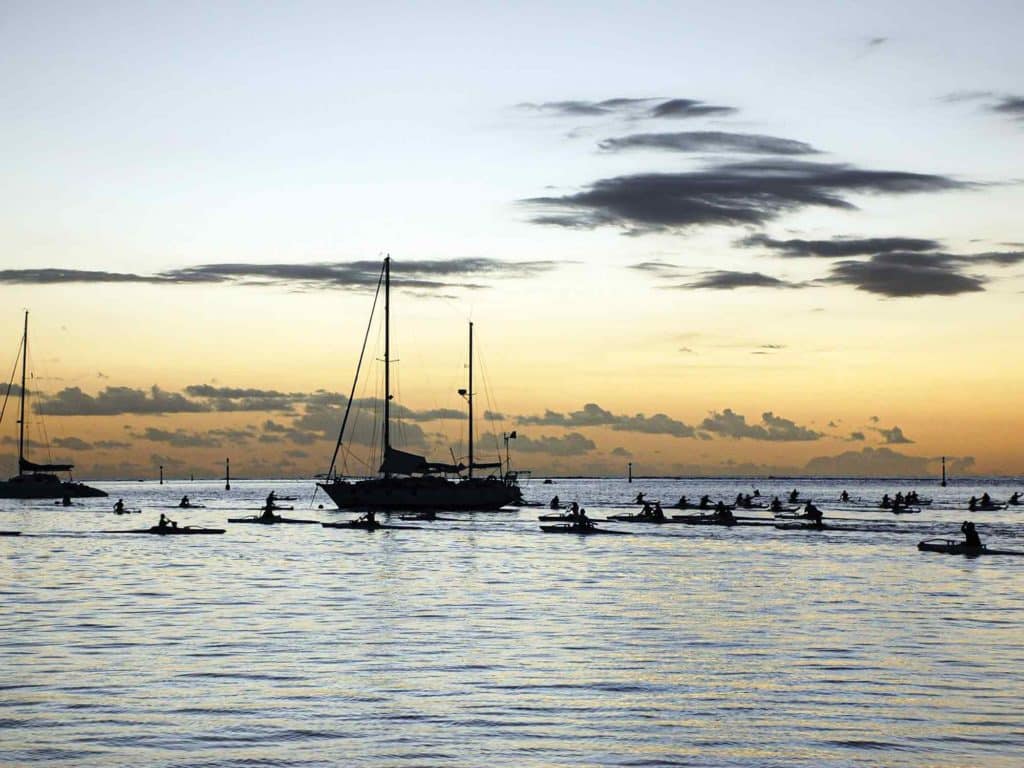
June, 2016: Stonington, Connecticut. Advance notice requirements made us wonder how hard it would be to clear back into our home country. Officer Alvarez drove an hour and a half from Bridgeport to clear us in at Stonington. We came ashore bearing a folio stuffed with the legacy documents of past clearances, our passports, and boat stamp and ink pads, and asked him what we needed to do. His response was unexpected: “Welcome home, family! Can I take a picture with you?”
Running down the dock (because you’re not in the USA until you set foot on land, Jamie said) our children got punchy calling out “American’”details they saw. Sometimes the obvious eluded them. What’s that?—it’s a fire hydrant. And that stick on it?—it’s to show how deep the snow is, and where the hydrant might be under the snow. No way! —Yes, really! Is that house a typical American house? Look, a flag! Another flag! (It’s picture-postcard New England and July 4th looms; there are a lot of flags.)
Returning to the US was dizzying. Cars, people, everything seemed to move too fast. Hurtling down the road in a car passing billboards hawking lawyers or plastic surgery or PSAs for drug addiction felt surreal. After years of witnessing human impacts on the natural world, it felt dissonant to be surrounded by a consumption-driven society that professed sustainability ideals. Strangers in our homeland: How much could be attributed to changes in the US during an eight-year gap, and how much to the changes that happened in ourselves? The season back on the US East Coast was a gift of time with loved ones, but we were unable to reenter a life we had once claimed.
Sailing up the Mystic River (where Jamie grew up) wasn’t intended as testing the waters of returning home—but in hindsight, we might have swung either way, particularly as our finances remained thin. Affirmed by our surroundings that we no longer fit in, we turned our focus to growing income streams further so that we could continue nomadic living. Jamie grew his work as a consulting sailmaker with Zoom Sails. We launched a service coaching hopeful cruisers, now an important part of our income, from a mooring near Mystic.
As we sailed down the coast toward Florida, a mix of age and proximity prompted 17-year-old Niall to visit college campuses and consider where he’d apply someday. Family chatter debated Totem’s route; mapping a path toward the Panama Canal, we played out the possibilities. “You could come home from first semester of college to be a line handler!” That snapped us into awareness that if Niall continued his college plans, we wouldn’t complete a circumnavigation as a family. This was acceptable to no one. He postponed college applications for a year, and we wound a path through the Caribbean, then north from the canal. Totem and crew crossed our outbound track in Zihuantenejo, Mexico, in April 2018—almost exactly an eight-year interval at the intersection point.
Circumnavigation was never a goal, but it’s an achievement we’re proud of, a gift we’ve been able to give our kids, an uncommon mantle we are fortunate to don.
Looking Ahead
We’ve lingered in Mexico for nearly two years after closing our circumnavigation. For the first time in years, we’re in range to affordably fly home for family needs: aiding my aging parents, and supporting Niall’s move to Oregon for college. Lingering indefinitely has never crossed our minds. We will cast off for the South Pacific again this spring.
Very little is planned beyond getting to the South Pacific. A second circumnavigation? Maybe. A loop of the Pacific? We’d love to see new places. Who knows? Beyond seasonal planning for weather, that level of detail isn’t important to us yet.
RELATED: Sailing Totem: Nautical Escapes for the Confined Sailor
The ultimate freedom that cruising offers has become thoroughly steeped in our bones. We have learned that it’s entirely possible to reinvent ourselves along the way to support our dreams. This conservative decision-making, overeducated non-risk-taker would never have believed it a dozen years ago! That it has transformed us into entirely different, entirely happier versions of our pre-cruising selves feels obvious in hindsight, and fuels our passion to help hopeful cruisers embark.
Back at anchor off La Cruz, I hear Siobhan fire up the outboard as she and Mairen head out to meet friends onshore. A bevy of teenagers are among the other boat families heading to the South Pacific: It bodes well! And so we continue this priceless cruising life, one day at a time.
Behan Gifford is the author of the popular cruising blog Sailing Totem, and a co-author of Voyaging with Kids: A Guide to Family Life Afloat. Follow the Gifford family’s adventures at cruisingworld.com/sailing-totem.

